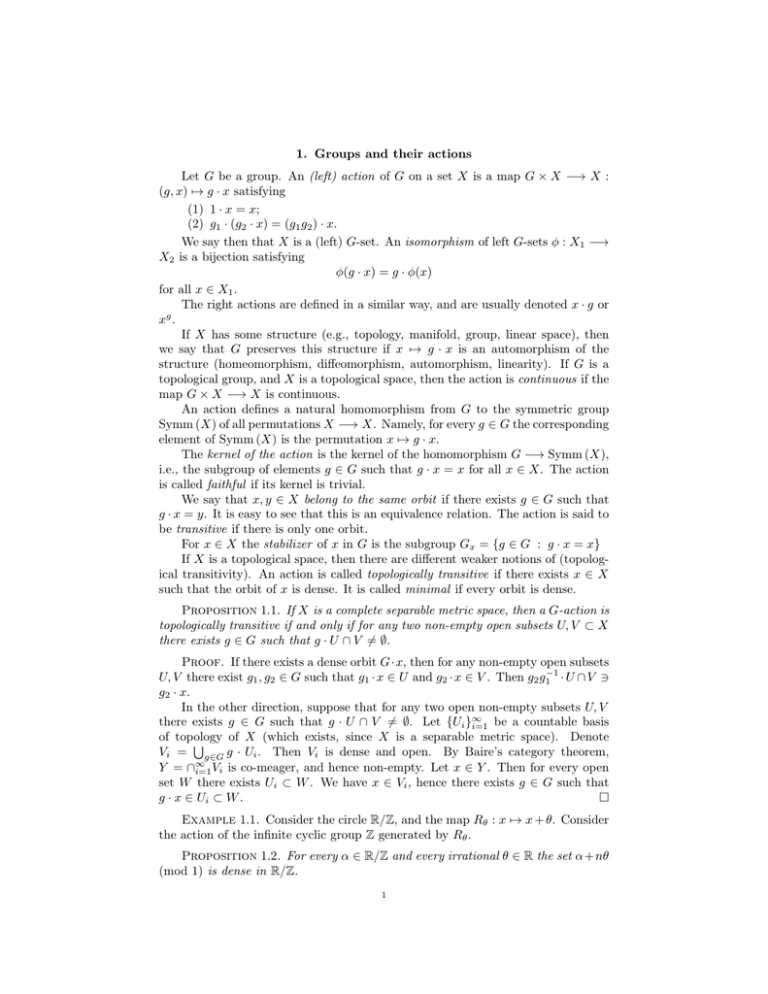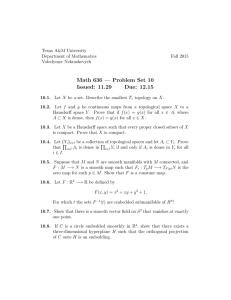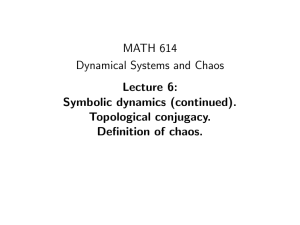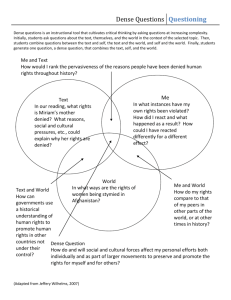1. Groups and their actions
advertisement

1. Groups and their actions
Let G be a group. An (left) action of G on a set X is a map G × X −→ X :
(g, x) 7→ g · x satisfying
(1) 1 · x = x;
(2) g1 · (g2 · x) = (g1 g2 ) · x.
We say then that X is a (left) G-set. An isomorphism of left G-sets φ : X1 −→
X2 is a bijection satisfying
φ(g · x) = g · φ(x)
for all x ∈ X1 .
The right actions are defined in a similar way, and are usually denoted x · g or
xg .
If X has some structure (e.g., topology, manifold, group, linear space), then
we say that G preserves this structure if x 7→ g · x is an automorphism of the
structure (homeomorphism, diffeomorphism, automorphism, linearity). If G is a
topological group, and X is a topological space, then the action is continuous if the
map G × X −→ X is continuous.
An action defines a natural homomorphism from G to the symmetric group
Symm (X) of all permutations X −→ X. Namely, for every g ∈ G the corresponding
element of Symm (X) is the permutation x 7→ g · x.
The kernel of the action is the kernel of the homomorphism G −→ Symm (X),
i.e., the subgroup of elements g ∈ G such that g · x = x for all x ∈ X. The action
is called faithful if its kernel is trivial.
We say that x, y ∈ X belong to the same orbit if there exists g ∈ G such that
g · x = y. It is easy to see that this is an equivalence relation. The action is said to
be transitive if there is only one orbit.
For x ∈ X the stabilizer of x in G is the subgroup Gx = {g ∈ G : g · x = x}
If X is a topological space, then there are different weaker notions of (topological transitivity). An action is called topologically transitive if there exists x ∈ X
such that the orbit of x is dense. It is called minimal if every orbit is dense.
Proposition 1.1. If X is a complete separable metric space, then a G-action is
topologically transitive if and only if for any two non-empty open subsets U, V ⊂ X
there exists g ∈ G such that g · U ∩ V 6= ∅.
Proof. If there exists a dense orbit G·x, then for any non-empty open subsets
U, V there exist g1 , g2 ∈ G such that g1 · x ∈ U and g2 · x ∈ V . Then g2 g1−1 · U ∩ V 3
g2 · x.
In the other direction, suppose that for any two open non-empty subsets U, V
there exists g ∈ G such that g · U ∩ V 6= ∅. Let {Ui }∞
i=1 be a countable basis
of topology
of
X
(which
exists,
since
X
is
a
separable
metric space). Denote
S
Vi = g∈G g · Ui . Then Vi is dense and open. By Baire’s category theorem,
Y = ∩∞
i=1 Vi is co-meager, and hence non-empty. Let x ∈ Y . Then for every open
set W there exists Ui ⊂ W . We have x ∈ Vi , hence there exists g ∈ G such that
g · x ∈ Ui ⊂ W .
Example 1.1. Consider the circle R/Z, and the map Rθ : x 7→ x + θ. Consider
the action of the infinite cyclic group Z generated by Rθ .
Proposition 1.2. For every α ∈ R/Z and every irrational θ ∈ R the set α+nθ
(mod 1) is dense in R/Z.
1
2
Proof. Denote by α mod 1 the number t ∈ [0, 1) such that α − t ∈ Z.
Since nθ mod 1 is infinite, for every N there exist n1 6= n2 and k ∈ {0, 1, . . . , N −
1} such that (n1 θ − n2 θ) mod 1 ∈ (k/N, (k + 1)/N ). Then |(n1 − n2 )θ| mod 1 <
1/N . We have shown that for every > 0 there exists n ∈ Z such that nθ
mod 1 < . Consider then the sequence 0, nθ, 2nθ, . . . of points of R/Z. It divides the circle into arcs of length less than . It follows that for every α ∈ R/Z
there exists k such that |α − nkθ| mod 1 < . Consequently, the orbit {nθ} of 0 is
dense in R/Z. Rotating the circle by α we see that orbit of α is dense in R/Z. Example 1.2. Consider a finite alphabet A, and let X = AZ be the topological
space of all maps w : Z −→ A (with pointwise convergence, where A is discrete).
Consider the shift map given by s(w)(n) = w(n + 1).
Proposition 1.3. The shift is topologically transitive but not minimal.
Proof. It is not minimal, since orbits of periodic sequences are finite. We
can find a sequence w such that for any finite word v there exists i such that
w(i)w(i + 1) . . . w(i + k) = v for some i and k. Then the orbit of w is dense.
One way to find such w is to list all possible finite words in a bi-infinite sequence
(which is possible since the set of all finite words is countable). Another way is
to write a sequence of independent random identically distributed letters (so that
each letter has a non-zero probability). For a given word v and given number i ∈ Z,
probability that v is not equal to w(i)w(i + 1) . . . w(i + |v| − 1) is strictly less than
one. It follows that probability that v is not a subword of a random infinite word w
is zero. Consequently, with probability 1 a random infinite word w ∈ AZ contains
every finite subword, i.e., its orbit under the shift is dense.







